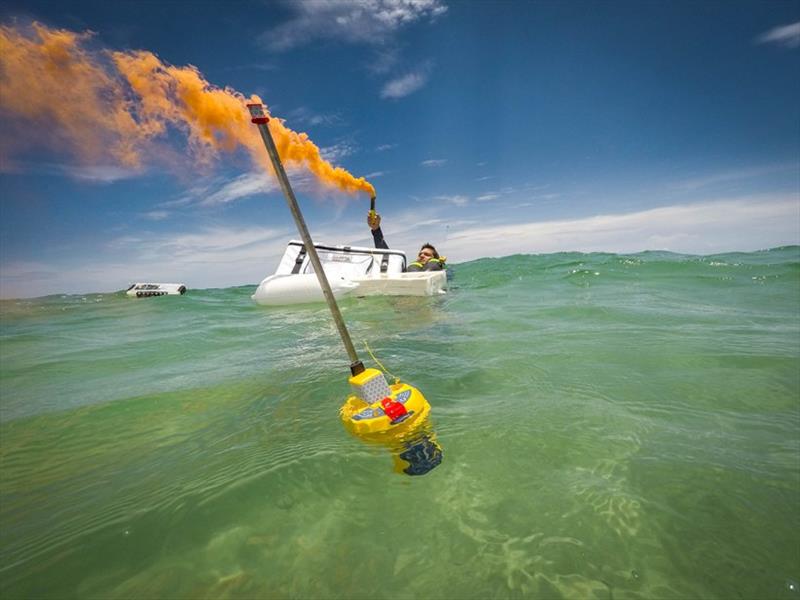
Annual 406Day raises beacon awareness as unprecedented numbers head for the great outdoors
by Saltwater Stone 6 Apr 2021 11:51 BST

406 MHz beacons, such as the Ocean Signal EPIRB, provide access to rescue services in an emergency © Ocean Signal
Today, on April 6th, UK marine safety specialists Ocean Signal and Ocean Safety are joining forces again to mark the annual 406Day, raising awareness and promoting the benefits of 406 MHz beacons as interest in outdoor recreational activities continues to surge.
With more people than ever before looking for ways to socially distance and head out on the water, participate in racing events or try new adventures in more remote areas on land, the 406Day message highlighting the importance of EPIRBs (Emergency Position-Indicating Radio Beacon) and PLBs (Personal Locator Beacon) takes on even greater significance in 2021.
This 406Day (#406Day21), Ocean Signal and its distributor Ocean Safety are urging new boaters, members of the racing community and outdoor enthusiasts to understand the life-saving features and responsibilities of owning a 406 MHz beacon so they can enjoy the outdoors safely this year and help the emergency services to find them quickly when a rescue operation is necessary.
James Hewitt, Managing Director, Ocean Signal, said: "There is a very high level of interest in safe outdoor recreational activities, including boating, so it is really important that people are properly prepared and equipped at all times. Before the season starts, 406Day is a great way for us to raise awareness about 406 MHz devices, particularly how to test and register your beacon. This year, our focus is to help anyone who may be less experienced in boating or other outdoor activities to understand that it is affordable and easy to invest in the right beacon. Ready for activation in an emergency to instantly access rescue services via the satellite network, these beacons are very easy to use and will provide reassurance at all times - and could end up saving your life."
"Ocean Safety is delighted to support and promote 406Day," added Alistair Hackett, Ocean Safety Managing Director. "It's a moment to celebrate the thousands of lives saved by the use of 406 MHz beacons, and importantly raise awareness of their lifesaving potential alongside the Copas-Sarsat satellite system."
For new users, Ocean Signal is raising awareness about the different types of beacons which operate on the 406 MHz frequency - EPIRBs for boats and PLBs for anyone participating in boating, watersports and outdoor adventures. Carried ready for activation in an emergency to instantly access rescue services via the designated 406 MHz Cospas-Sarsat satellite system, each MHz beacon transmits a unique digital code that identifies the type of beacon and allows registration data to be associated with the device. The registration data provides information such as the beacon owner, the type of vessel and emergency points of contact. All beacon owners should then update their beacon registration, check their battery expiration date, and self-test their beacons to make sure they are working perfectly.
Ocean Signal provides a free replacement beacon for all owners of its rescueME and SafeSea devices who activate their PLB or EPIRB in an emergency. Ocean Safety offers visual inspection and test sequence check of all leisure beacons at their four UK branches. The company can also assist with registry queries, battery replacements, fitting PLBs to customer lifejackets, safe disposal of unwanted PLBs and EPIRBs and special offers on new units.
Ocean Signal offers the following simple advice to beacon owners to ensure their EPIRB, or PLB will operate effectively in the event of an emergency.
1. Register and update your 406 MHz beacon registration
All beacon owners should register their device with the appropriate authorities. UK users of EPIRBS and PLBs should register their details on the UK Beacon Registry here. This free and simple registration will speed up a rescue and provide Search and Rescue with information about you and your vessel which is vital in an emergency. In other countries contact your local authority. Details can be found here.
2. Check your 406 MHz beacon battery expiration dates
Users must check the expiry dates to ensure the EPIRB or PLB will function correctly when required in an emergency. When selecting your beacon, key considerations include the added convenience of user replaceable batteries and the reassurance of a long battery operating life. Ocean Signal leads the industry in these areas of innovation. The rescueME PLB1 has a seven-year battery life, while the rescueME EPIRB1 has even longer battery life at a massive ten years between routine replacements.
3. Test your 406 MHz beacon
You should test your EPIRB using the 'self-test mode' once a month to monitor the 406 MHz RF power, as well as the 121.5 MHz homer RF power, synthesiser lock and battery voltage under load. Ocean Signal also recommends regular inspection to ensure: no obvious signs of damage, including the state of the antenna; secure mounting on the bracket or float free housing; the lanyard is not attached to any structures; the HRU (Hydrostatic Release Unit) in the case of a float free housing is within the specified expiry date; the EPIRB and mounting is cleaned, only using a damp cloth. It is also recommended to carry out routine testing of your PLB to ensure it is in good working order, using the specified 'Test' key. Ocean Signal suggests you do not test the GPS receiver more than once a year as it expends significant amounts of battery energy.
For information about the full range of products available from Ocean Signal, please go to www.oceansignal.com. For information on Ocean Safety, go to www.oceansafety.com.